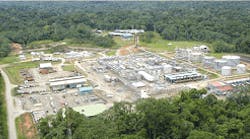Repsol recently upgraded the SISs and networks at its NPF and SPF exploration and production plants in eastern Ecuador with ControlLogix from Rockwell Automation, which let it meet the IEC 61511 safety standard and resolve equipment obsolescence and downtime issues. Source: Repsol and Rockwell Automation
Operations at Repsol's two exploration and production (E&P) plants in eastern Ecuador began in 1994 and 1997, respectively. However, after running productively for almost 20 years, the company needed to update their safety instrumented systems (SIS) to bring them into compliance with its new internal E&P safety standards based on IEC 61508 and IEC 61511, as well as address the aging equipment's obsolescence risks and lack of data visibility for maintaining them.Consequently, Repsol conducted several risk analyses (RA) in 2013, which included safety integrity level (SIL) and hazard and operability (HazOp) analyses at the NPF and SPF sites to determine what SIS upgrades they'd need to comply with the standard. It also worked with safety consultant exida and Rockwell Automation, and settled on a Allen-Bradley ControlLogix-based SIS that easily integrated with the PLC-5 it would replace, an installed base of Rockwell Automation devices, and equipment from other suppliers. Repsol also installed new fiber-optic networks at the plants for communicating between controllers and I/O racks, and used alarming and events capabilities in the new system to gain better visibility into performance and downtime issues.
“Sharing information across different systems is possible but not always easy, and sometimes it requires bringing in outside experts,” says Marcelo Villegas, project engineer, Repsol Ecuador. “That wasn’t the case with the Rockwell Automation's system, which gave us a clean interaction between the different systems that we had in place.”
Because the NPF plant is smaller with only about 1/4 the capacity of the SPF plant, Repsol used it as a proving ground for the first of the two SIS migrations. The migration at NPF was completed in 21 days, and finished at the much-larger SPF in the same amount of time. Both were completed without interrupting production.
Repsol workers can use alarms and events in their new SIS to access information about system performance to improve troubleshooting if a failure occurs. They can also use real-time performance data to predict where failures are likely to occur to help avoid downtime. “We didn’t have any insights into failures in the previous systems,” adds Villegas. “The new system allows us to monitor every part of the architecture, whether it’s the controller, different I/O racks or a specific output signal. This can help us more quickly identify the root cause of a failure and in some cases anticipate where a failure is likely to happen.”
In the future, Repsol expects its SIS to give it greater flexibility for meeting safety requirements. Both plants presently have SIL 1 safety requirements, but the new SIS gives them SIL 2 performance if they ever need it. should it someday be necessary. “These systems will help us get ahead of potential SIL requirement increases without another SIS upgrade in the future,” adds Villegas.






